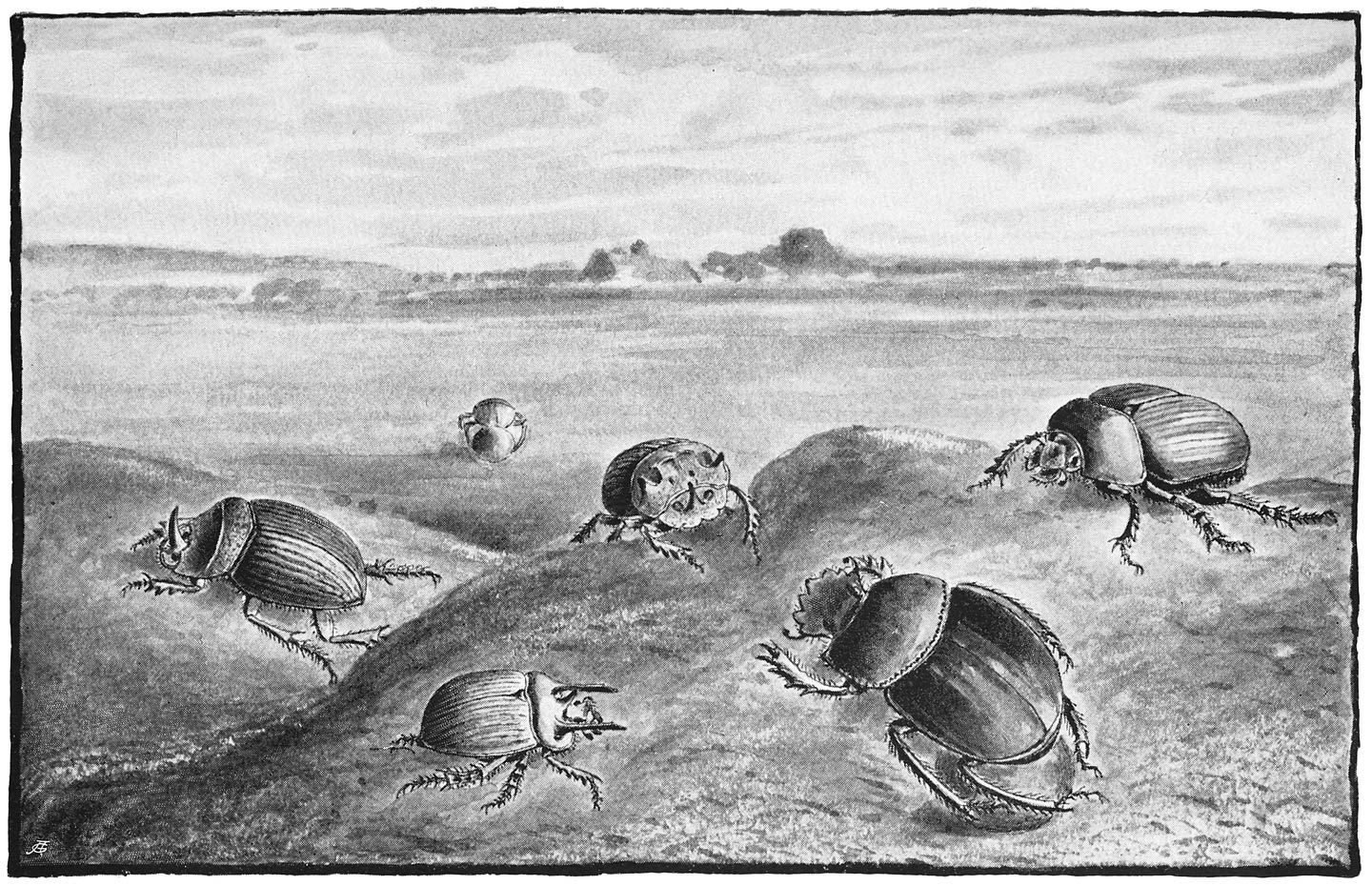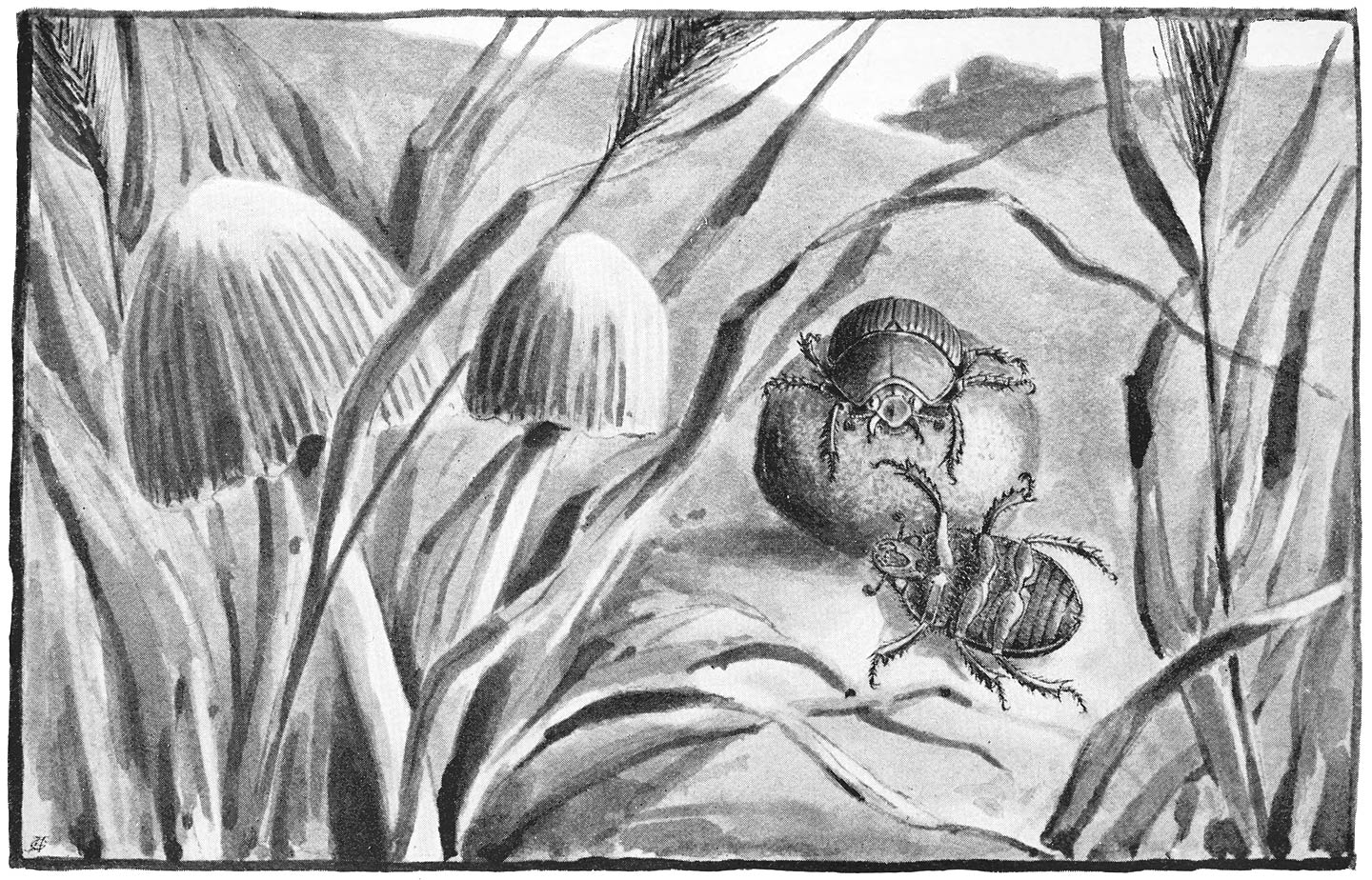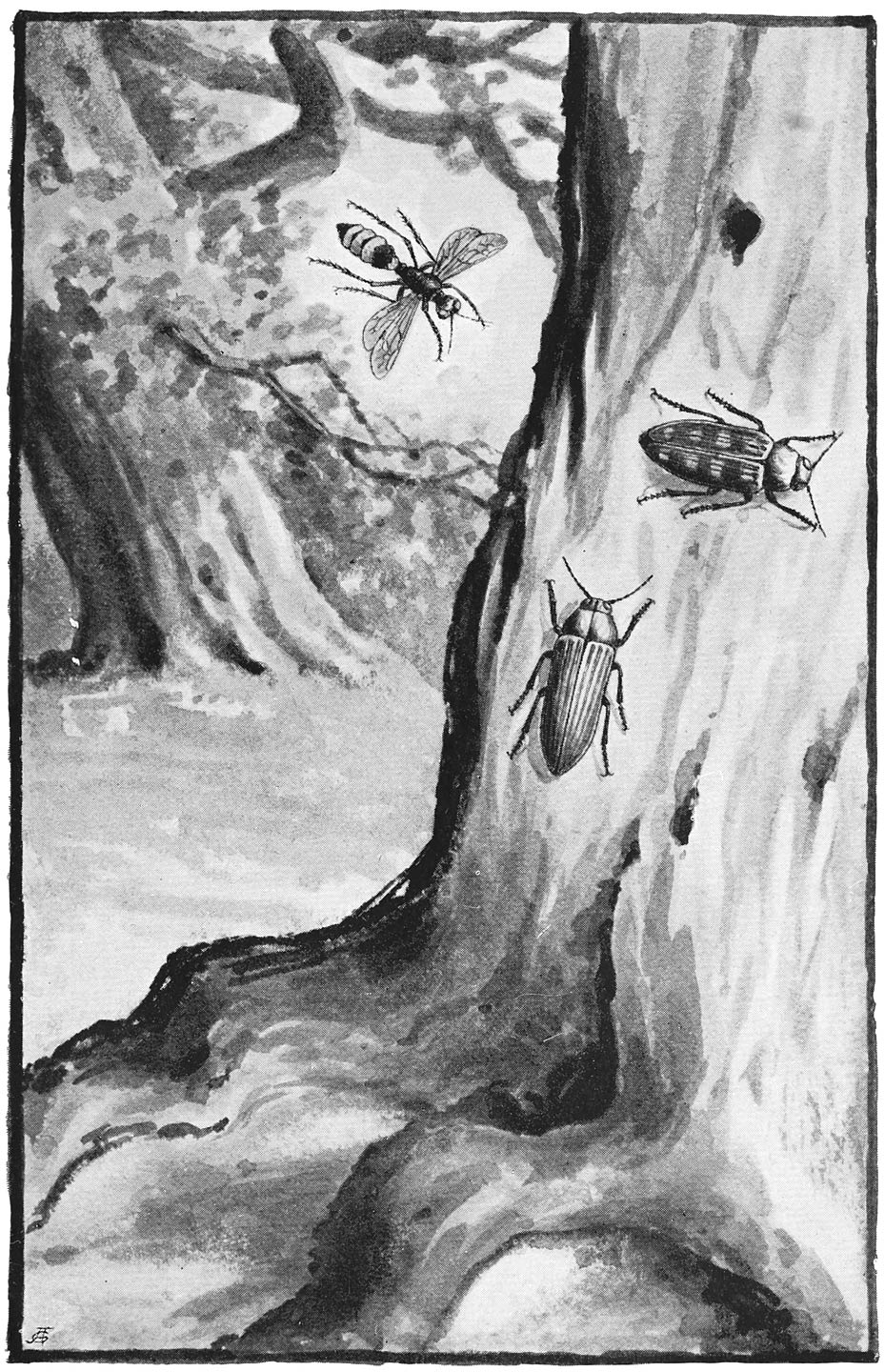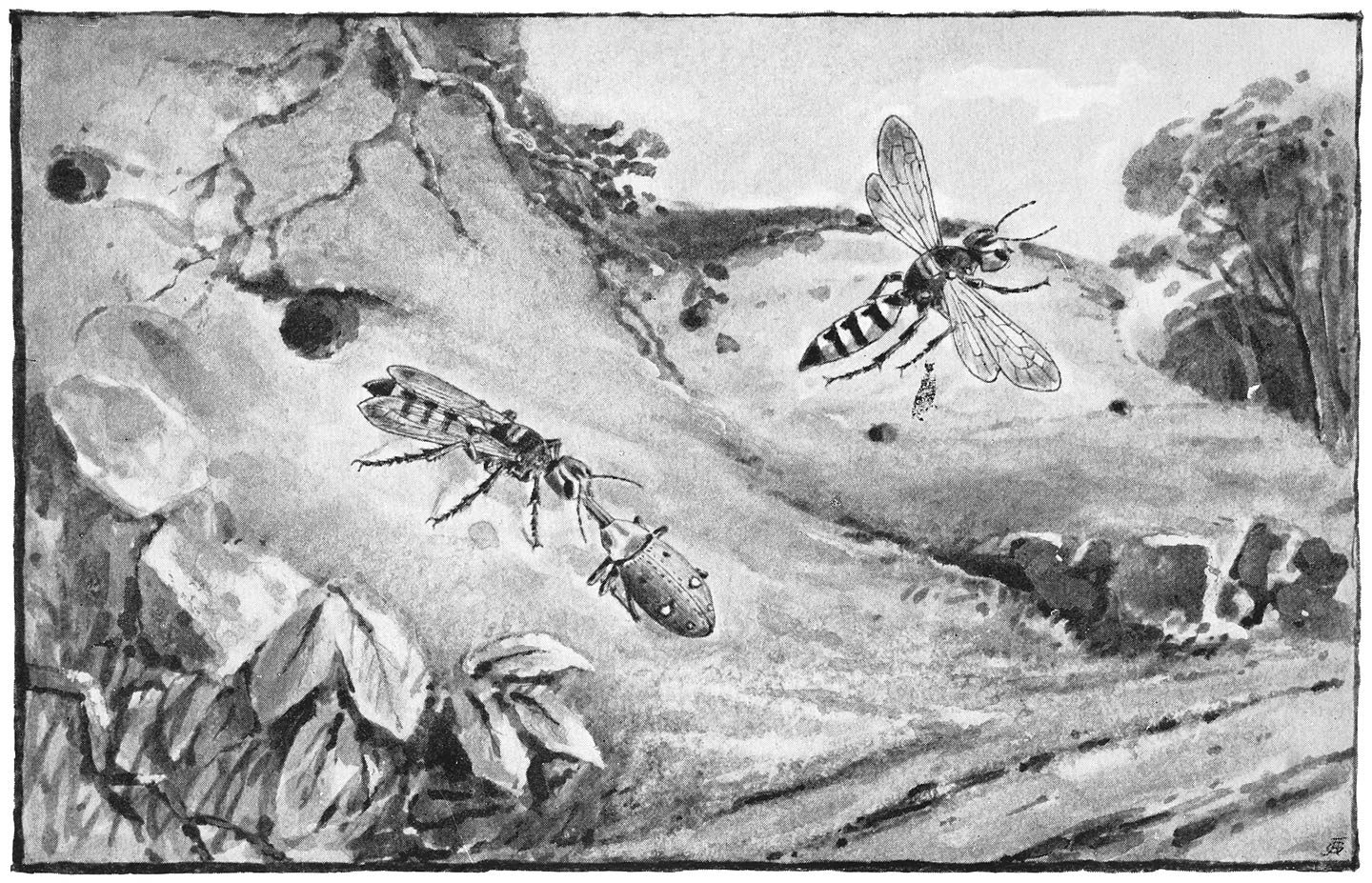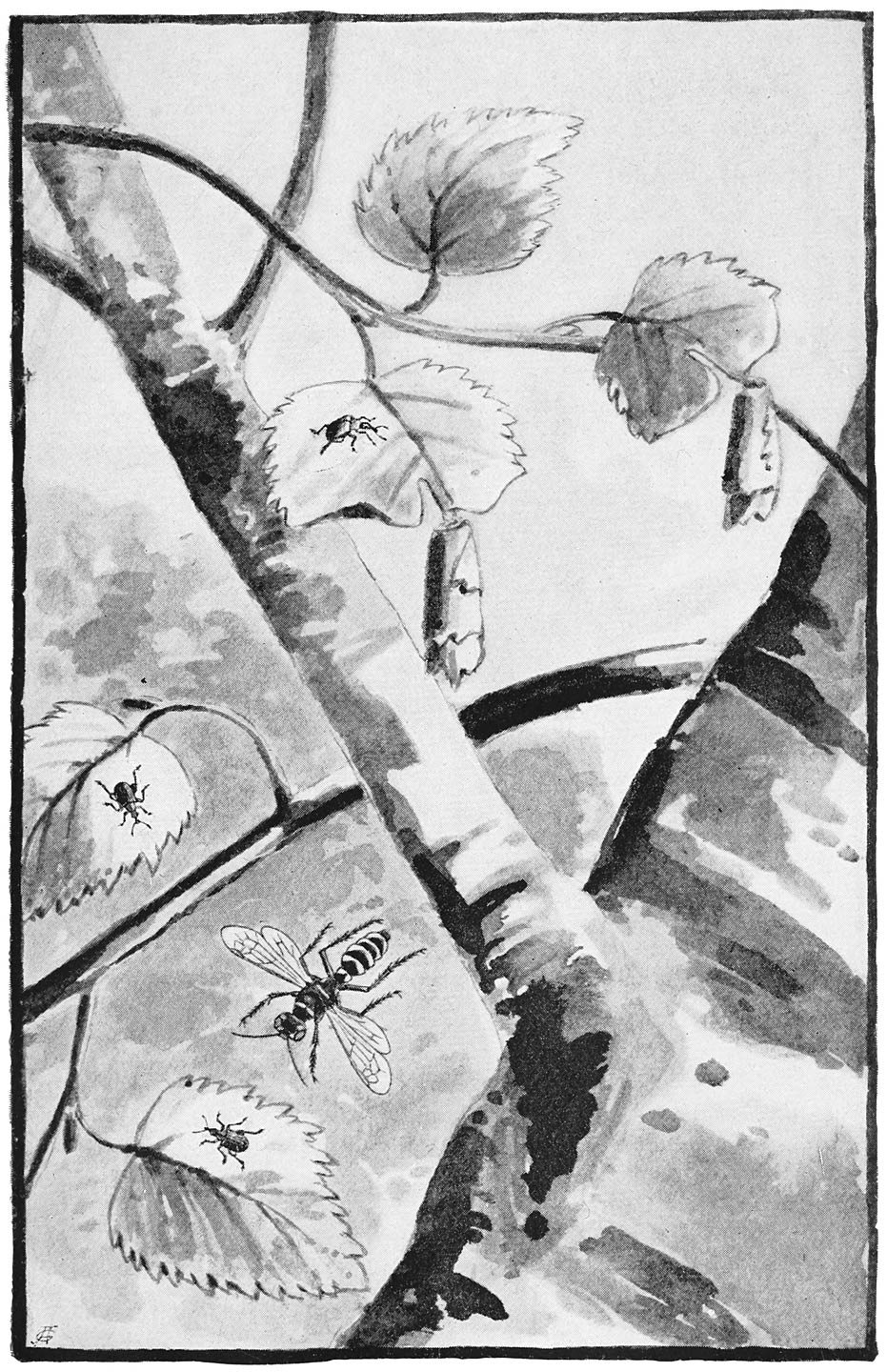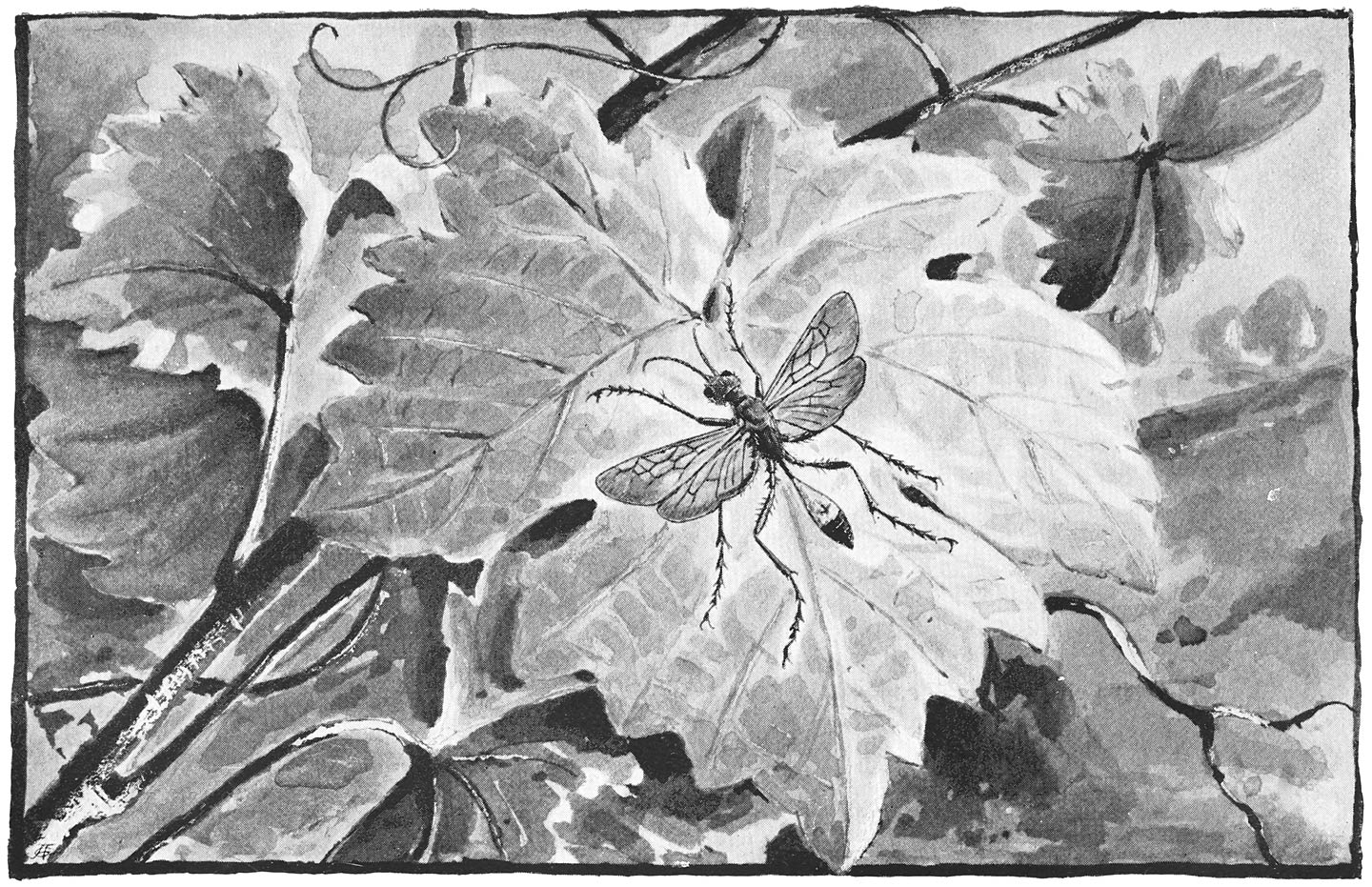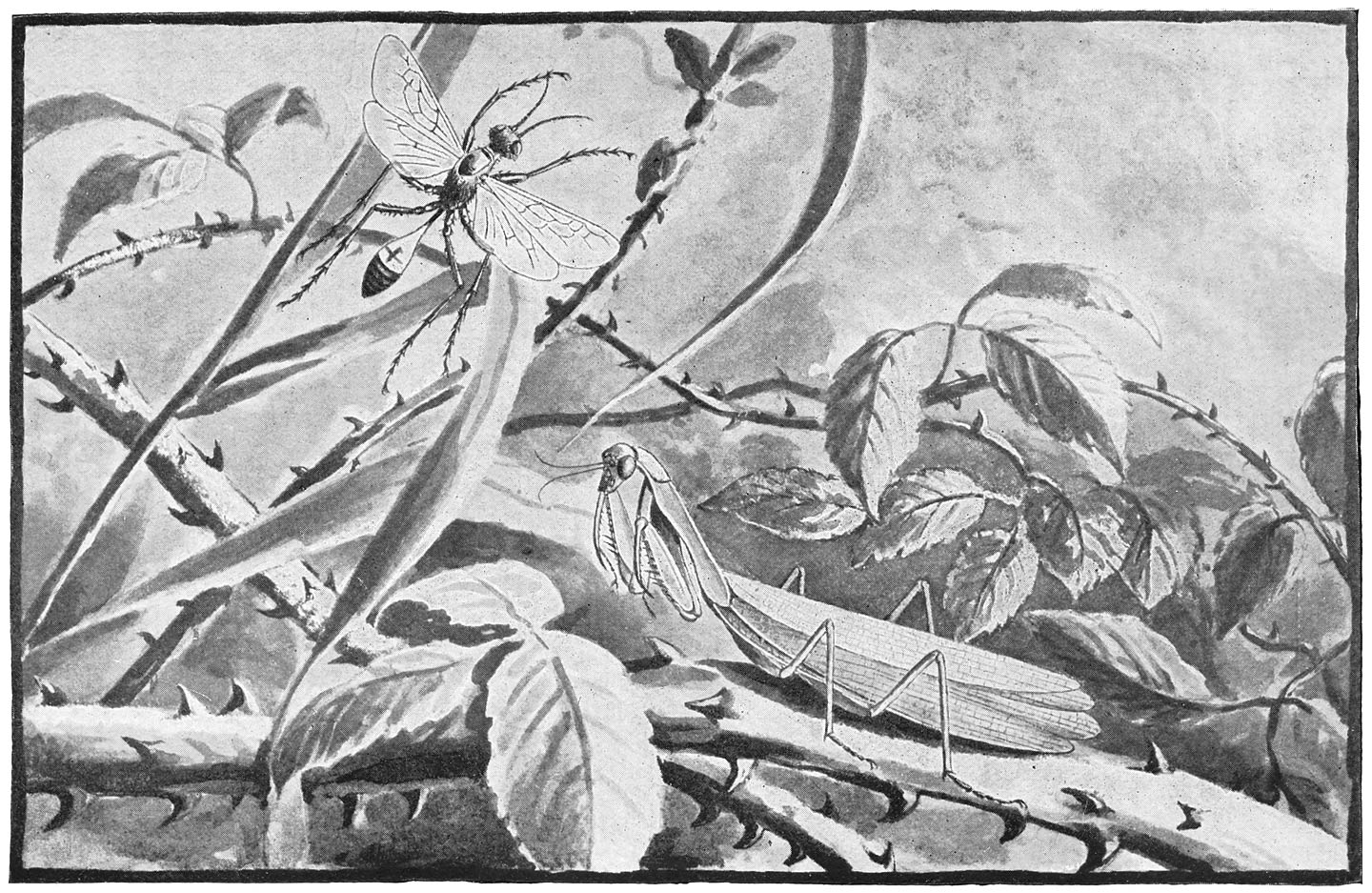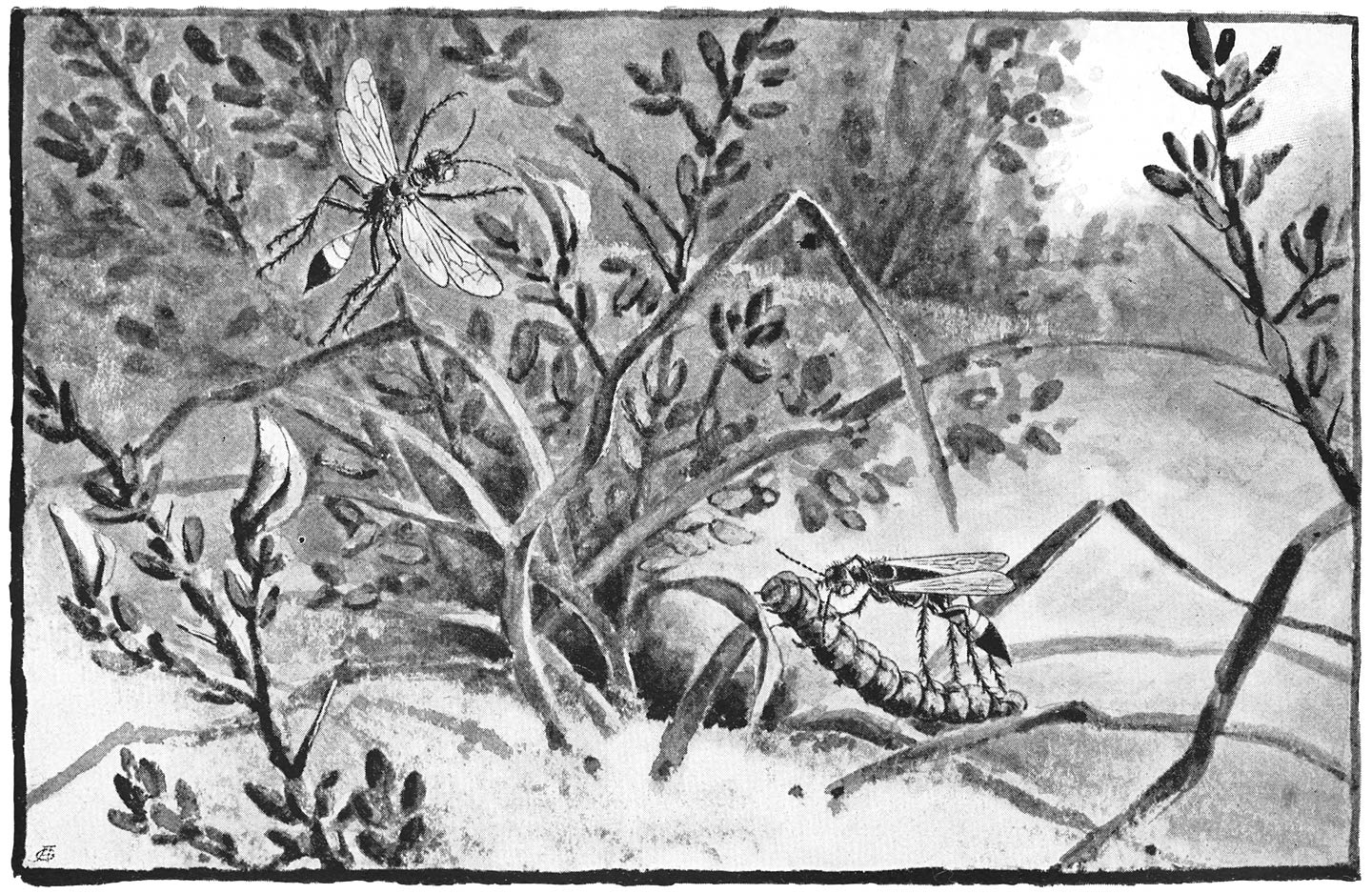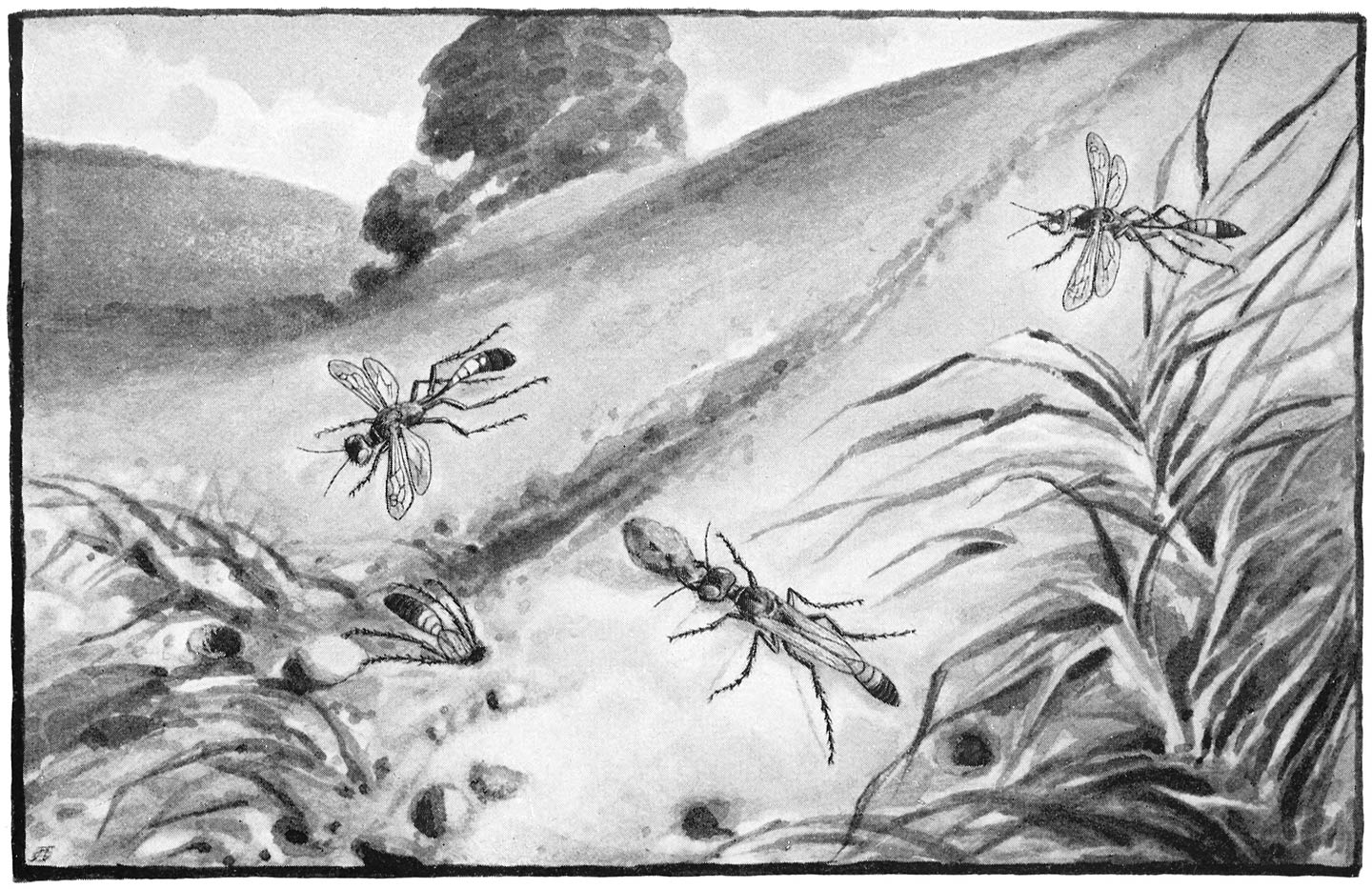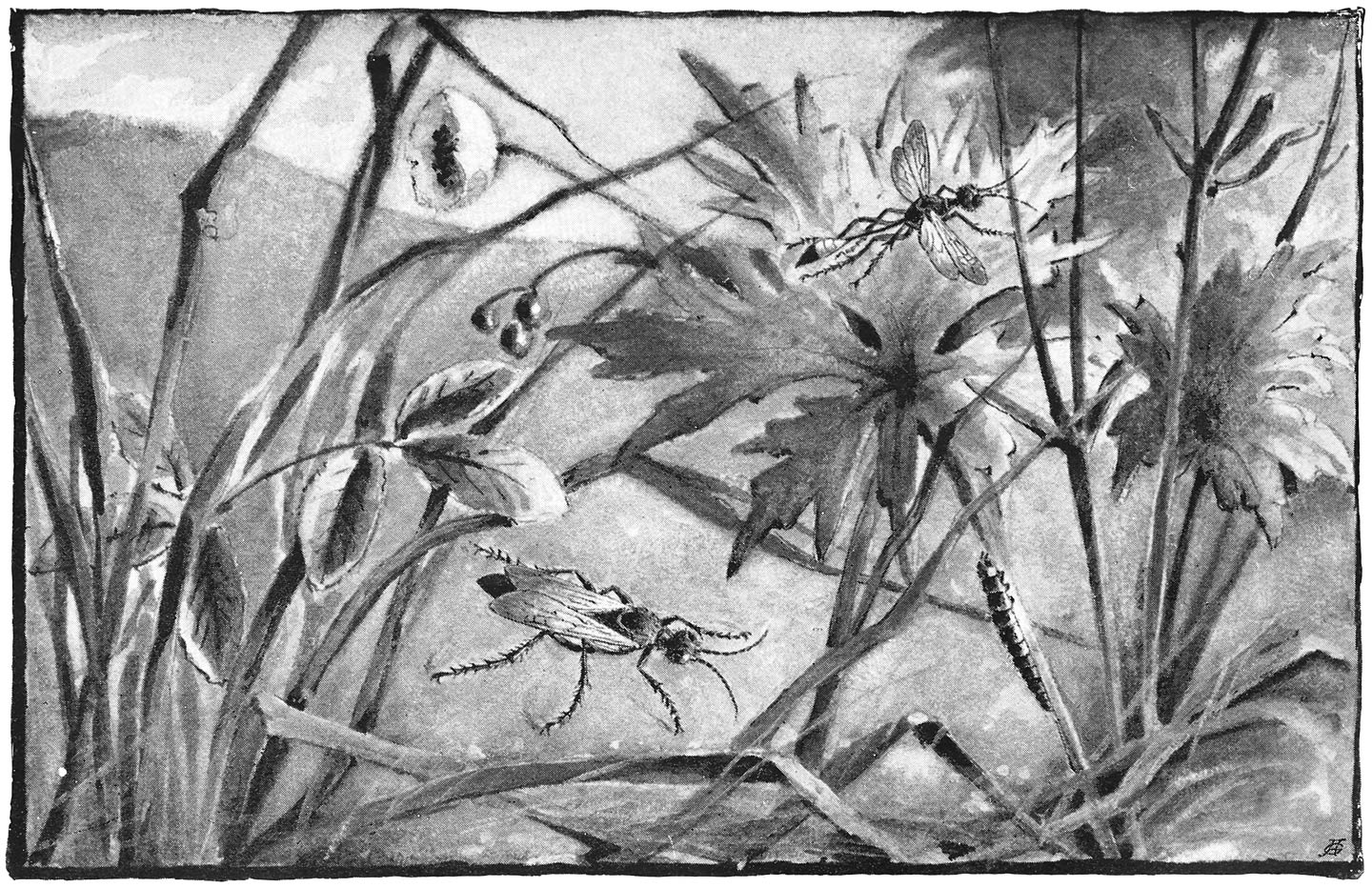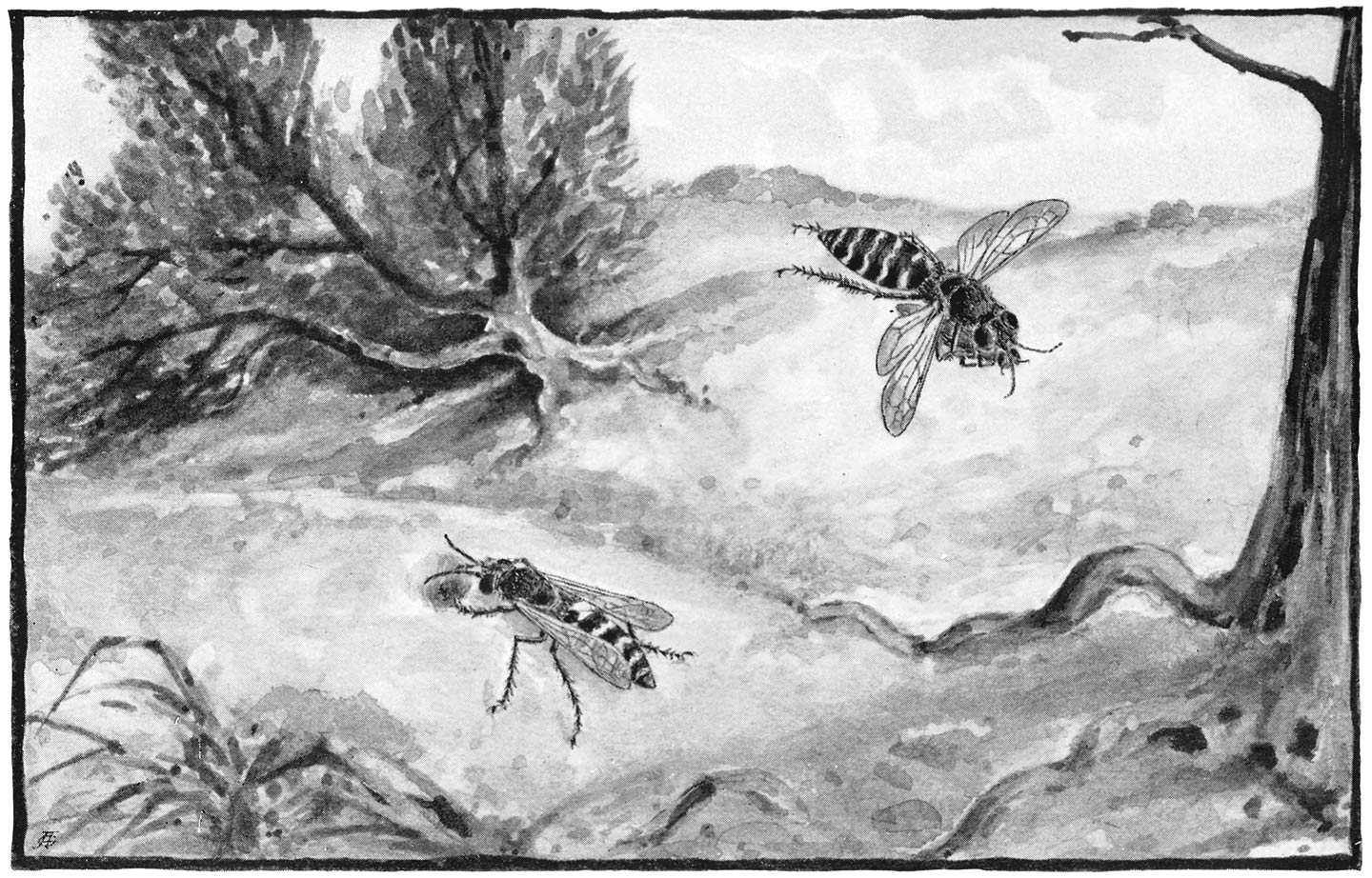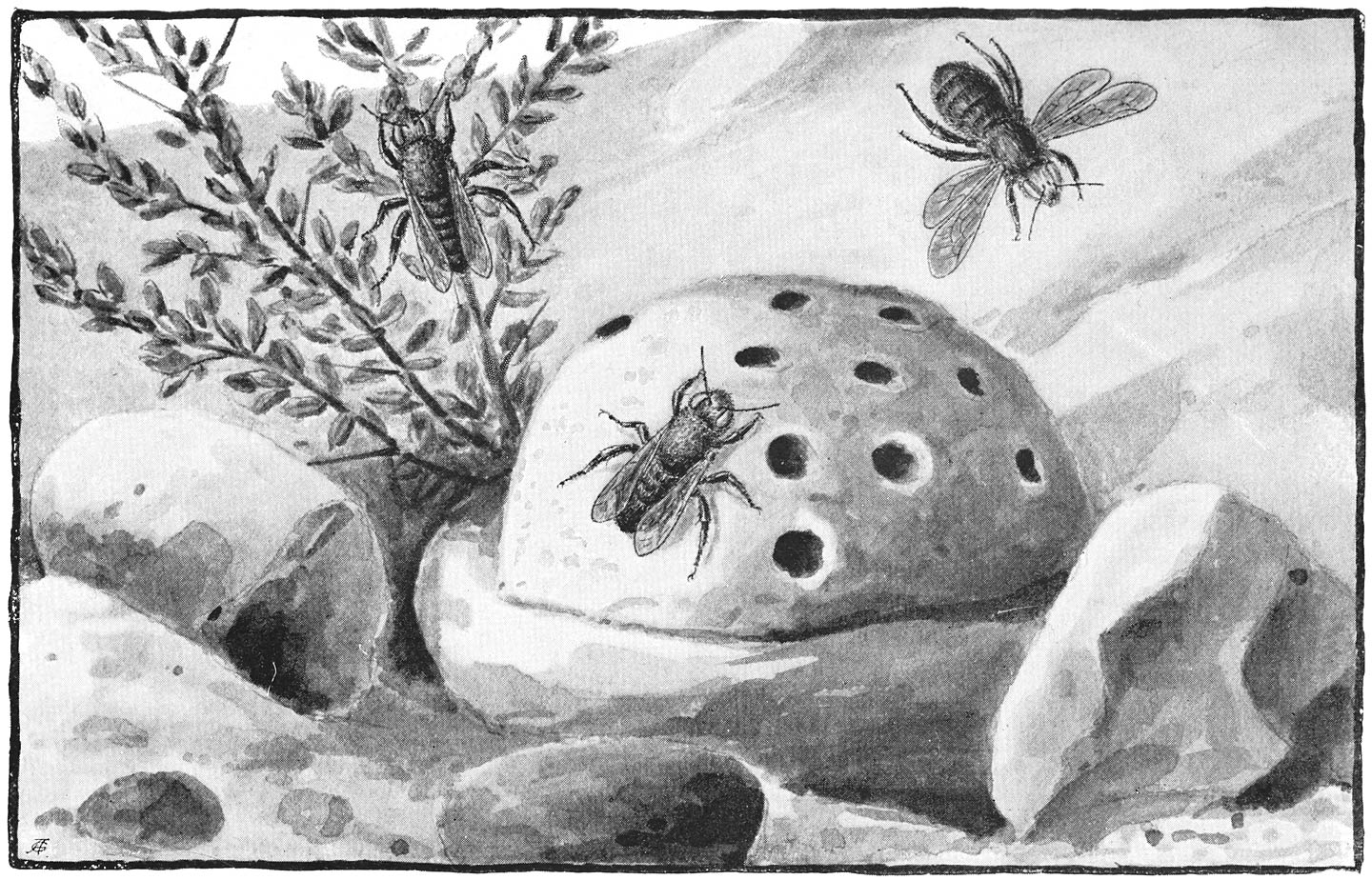This was how it came about. We were five or six, I the oldest and their professor,
still more their comrade and friend; they, young fellows with warm hearts and lively
imaginations, overflowing with that youthful vitality which makes one so open to impressions
and so eager for knowledge.
Talking of one thing and another we followed a path bordered with elder and hawthorn,
where already the Rose Beetle was revelling in the overwhelming scent of the clustering
blossoms. We were going to see if the Sacred Scarabæus had yet appeared on the sandy
plateau of Les Angles, rolling the ball of dung which ancient Egypt looked on as emblematic
of the world; we wanted to discover whether the running stream at the bottom of the
hill might not hide young newts under the net of water weeds—newts whose branchiæ
look like tiny sprays of coral; to see if that elegant little fish of the rivulet,
the stickleback, had donned his wedding cravat of azure and purple; if the new-come
swallows were [2]dipping on pointed wings over the meadows chasing the midges which scatter their eggs
in their airy dance; to see if the Eyed Lizard was sunning his blue-spotted body at
the mouth of a hole made in the sandstone; or if the flocks of Laughing Gulls, come
up from the sea after the legions of fish which ascend the Rhône to spawn, were hovering
over the river, and now and again uttering their cry like the laugh of a maniac. But
enough; suffice it to say that, like simple folk who find much pleasure in living
with the brute creation, we were intending to spend a morning in enjoying the ineffable
awakening of life in springtime.
We were not disappointed. The stickleback was in full dress, his scales would have
made silver look dim; his throat was of the brightest vermilion. On the approach of
a great horse-leech with no good intentions, up rose the spines on back and side as
if moved by a spring. Thus bravely encountered, the bandit beat an ignominious retreat
down among the water-plants. The dull race of molluscs, Planorbinæ, and water-snails
were sucking in air on the surface of the water, and the great Water Beetle, with
its hideous larva, went by wringing the neck now of one, now of another, without the
stupid band seeming to notice it. But let us leave the waters of the plain and climb
the steep cliff dividing us from the tableland where sheep are feeding and horses
are being exercised for the approaching races, one and all bestowing largesse on the
rejoicing dung beetles.
For here at work are the scavenger beetles to whom is entrusted the high office of
clearing the [3]ground of impurities. It is impossible to admire sufficiently the variety of tools
with which they are furnished, both to stir the dung with, to divide and shape it,
and to hollow the deep retreats into which they shut themselves with their booty.
These tools form a kind of technological museum, where there is a specimen of every
kind of digging instrument. Some might be copied from those devised by human industry,
others are of an original type, and might serve as models for new tools for man. Copris
hispanica wears a strong horn on its head, forked and bent back, like the long spike
of a pickaxe. To a similar horn C. lunaris adds two strong points, shaped liked a
ploughshare, projecting from the thorax, and between them a sharp-edged protuberance,
serving as a wide rake. Bubas bubalus and B. bison, both exclusively Mediterranean
species, have foreheads armed with two stout, diverging horns, between which projects
a horizontal share from the corslet. Geotrupes typhæus carries three points on the
front of its thorax, parallel and standing straight out, the middle one shorter than
the others. Onthophagus taurus owns as implements two long curving appendages like
the horns of a bull, while the furcate Onthophagus has a two-pronged fork on its flat
head. Even those least well off have on one part or other hard tubercules—tools blunt
indeed, but which the patient insect knows very well how to utilise. All are furnished
with a shovel, i.e. a large, flat, sharp-edged head; all use a rake—in other words, they collect materials
with their toothed front legs.
As compensation for their unpleasant work, [4]more than one gives out a strong scent of musk, and its ventral parts gleam like polished
metal. Geotrupes hypocrita has the under part of its body bright with metallic lights
of copper and gold, and G. stercorarius with amethystine violet. But the usual colour
is black. It is in tropical regions that we find dung beetles in gorgeous array—absolutely
living jewels. Under camel droppings in Upper Egypt is found a beetle rivalling the
dazzling green of an emerald; Guiana, Brazil, Senegal, can show Copridæ of a metallic
red, rich as the red of copper, bright as that of a ruby. If such a jewelled race
be wanting to our country, still its dung beetles are not less remarkable for their
habits.
What eagerness is displayed around a dropping! Never did adventurers from the four
corners of the world show such eagerness in working a Californian claim! Before the
sun grows too hot there they are by hundreds, large and small, pell-mell, of every
kind and form and shape, hastening to secure a slice of the cake! Some work in the
open air and rake the surface, some open galleries in the thickest part, seeking choice
morsels, others toil in the under part and bury their treasure as soon as possible
in the adjacent ground, and the smallest crumble some scrap fallen from the excavations
of their strong fellow-workers. Some again—newcomers, and doubtless the hungriest—eat
then and there, but the aim of the greater number is to lay up a store which will
allow them to pass long days of plenty down in some sure retreat. A fresh dropping
is not to be found just when wanted in a plain where no thyme grows; such a gift is
[5]indeed a piece of good fortune, and only comes to the lucky. So when found, the wealth
is prudently stored. The smell has carried the good news a couple of miles round,
and all have rushed to gather up provender. Some laggards are still coming in on the
wing or on foot.
What is the one now trotting towards the heap, fearing to arrive too late? His long
legs work with a brusque, awkward action, as if moved by some machine inside him;
his little red antennæ spread their fans—sure sign of anxious greediness. He is coming,
has arrived, not without upsetting some of the guests. It is the Sacred Beetle, all
in black, the largest and most celebrated of our dung beetles.
Here he is at table, beside his fellow-guests, who are giving last touches to their
balls with the flat of their large front legs, or enriching them with a last layer
before retiring to enjoy the fruit of their labours in peace. Let us follow this famous
ball in each stage of construction.
The edge of the beetle’s head is large and flat, and armed with six angular teeth
arranged in a semicircle. It is the tool for digging and dividing, the rake to lift
or reject such vegetable fibres as are not nutritious, to seek out what is best and
rake it together. A choice is thus made, for these keen connoisseurs like one thing
better than another—a somewhat careless choice, indeed, if the beetle alone be concerned,
but one which is rigorously scrupulous if the maternal ball be in question, with its
central hollow where the egg will hatch. Then every scrap of fibre is rejected, and
only the quintessence of the stercorous matter is used to build the inner layer of
[6]the cell. Then, as soon as it is hatched, the young larva finds in the walls of its
dwelling a dainty food which strengthens digestion and enables it later to attack
the coarse outer layers. For its own needs the beetle is less fastidious, contenting
itself with a general selection. The toothed head hollows and seeks, rejects and gathers,
somewhat at haphazard. The forelegs aid mightily. They are flattened, bent into the
arc of a circle, are furnished with strong nerves and armed with five stout teeth.
If an effort has to be made, an obstacle overthrown, a path forced through the thickest
part of the heap, the dung beetle elbows its way; in other words, throws its toothed
legs right and left, and clears a half circle with a vigorous sweep of its rake. Room
being made, these same feet have a new task; they collect bundles of the material
raked up by the head, and pass it under the insect to the four hind-feet. These are
planned for the turner’s trade. The legs, especially the last pair, are long and slender,
slightly bent in an arc, and ending in a very sharp spur or talon. A glance shows
that they form a spherical compass, capable of holding a globe in the bent legs to
verify and correct its shape. In fact, their mission is to shape the ball. Bundle
after bundle the material accumulates under the insect, held between the four legs
which by a slight pressure lend it their own curve and something of shape. Then from
time to time the rough hewn ball is set in motion between the legs of the double spherical
compass, turned underneath the beetle, and rolled into a perfect sphere. Should the
outer layer fail in plasticity and threaten to scale off, or if some [7]part be too fibrous, and refuse to be shaped by rotation, the faulty part is retouched
by the forefeet; little taps of their broad surface give consistency to the new layer
and imbed the recalcitrant fibre in the general mass. When the sun shines and work
is urgent, one is amazed by the feverish activity with which the turner labours. Work
goes on fast; first there was a pellet, now it is as large as a nut, by and by it
will be of the size of an apple. I have seen some greedy beetles make up a ball as
large as an apple. Assuredly there is food in the larder for some days to come!
Provender being gathered, the next thing is to retire from the mêlée, and carry it to a fitting place. Now we see some of the most characteristic habits
of the Scarabæus. He sets out at once, embracing the ball with the long hind legs,
whose talons, planted in the mass, serve as pivots—leans on the intermediary legs
as pivots, and using as levers the flat of the toothed forefeet, which press the ground
alternately, journeys backward with his load, the body bent, the head low, and the
hinder part upraised. The hind feet, which are the chief organs in the mechanism,
move continually, going and coming and changing the place where the talons are stuck
in, to alter the axis of rotation, to keep the load balanced and advance by an alternate
push right and left. Thus the ball comes in contact with the ground in every part
of it, which gives it a perfect shape and lends consistency to the outer layer by
a uniform pressure. Courage! it moves, it rolls, and the journey’s end will be reached,
though not without trouble. Here is a first difficulty. The beetle [8]has to cross a slope, and the heavy ball would naturally follow the incline, but for
reasons best known to itself, the insect prefers to cross this natural slope—an audacious
plan, which one false step or a grain of sand to upset the balance will defeat. The
false step is made, the ball rolls to the bottom of the valley, and the insect, upset
by the impetus of its load, staggers, gets again on its legs, and hastens to harness
itself afresh. The mechanism works capitally. But look out, scatterbrain! follow the
hollow of the valley, it will spare labour and misadventure. The road is good and
quite level, and your ball will roll along with no exertion. Not a bit of it. The
insect has made up its mind to remount the slope already so fatal to it. Perhaps it
suits it to return to the heights. Against that I have nothing to say, the Scarabæus
knows better than I do whether it be advisable to dwell in lofty regions. At all events,
take this path which will lead you up by a gentle incline. Not at all. If there be
near at hand some very stiff slope impossible to climb, then that slope this wrong-headed
insect prefers. Then begins the labour of Sisyphus. With endless precautions the monstrous
load is painfully hoisted, step by step to a certain height, the beetle always going
tail first. One asks one’s self by what miracle of statics such a mass can be kept
on the slope. Ah! a clumsy movement brings all this toil to naught. Down goes the
ball, dragging the beetle with it. The escalade is repeated, soon followed by a fresh
fall. The attempt is renewed, and better managed at the difficult points; a nasty
grass-root, which occasioned the previous tumbles, is prudently [9]turned; we have almost got to the top. But gently! gently! the ascent is perilous,
and a mere nothing may ruin all. A leg slips on a bit of smooth gravel, and ball and
scavenger roll down together. The beetle begins all over again, with tireless obstinacy.
Ten times, twenty times, will it attempt that further ascent, until persistency vanquishes
all obstacles, or until, better advised, it takes the level road.
The scavenger does not always roll his ball single-handed, but frequently takes a
partner, or rather, a partner takes him. The affair is usually managed thus: the ball
being prepared, a beetle comes out of the throng, pushing it backwards. One of the
newcomers, whose own work is hardly begun, leaves its task and runs to the ball, now
in motion, to lend a hand to the lucky proprietor, who appears to accept the proffered
aid in an amiable spirit. The two work as partners, each doing its best to convey
the ball to a place of safety. Was a treaty made in the workshop, a tacit agreement
to share the cake? While one kneaded and shaped, was the other tapping rich veins
whence to extract choice material for their common use? I have never observed such
collaboration, but have always seen every beetle exclusively occupied by his own affairs
on the field of labour, so that the last comer has no acquired rights.
Is it, then, an association of the two sexes, a couple about to set up house? For
a time I thought so. The two scavengers pushing a ball, one before and one behind,
with equal zeal, used to remind me of certain couplets once on a time popular on barrel-organs—
Pour monter notre ménage, hélas comment ferons-nous?
Toi devant, moi derrière, nous pousserons le tonneau.
[10]
But the evidence of the scalpel forces me to give up this family idyll. There is no
outward sign of sex in the Scarabæus, but on dissecting a couple employed on one and
the same ball they often turned out to be of the same sex. In fact, there is neither
community of family nor community of labour. What, then, is the reason of the apparent
partnership? Merely an attempt at filching. The eager fellow-worker, under pretence
of giving a helping hand, cherishes the project of carrying off the ball at the earliest
opportunity. To make one for itself at the heap demands labour and patience; to abstract
a ready-made one, or at least to foist one’s self in as a sharer of the feast, is
much more convenient. If the owner’s watchfulness should slacken, one will flee with
the treasure; if too closely looked after, one can at least sit down at table on the
pretext of services rendered. With such tactics all turns to profit, so that pillage
is carried on as one of the most lucrative of trades. Some, as I have just said, play
an underhand game, hastening to the aid of some comrade who has not the least need
of them, and under the cloak of charitable assistance conceal a highly indelicate
greed. Others, bolder or more confident in their strength, go straight to the goal
and rob by main force. Every moment some such scene as this will take place. A beetle
departs alone, rolling his ball, his own property, acquired by conscientious labour;
another comes flying, whence I know not, drops heavily, folds his smoky wings under
their elytra, and with the back of his toothed feet oversets the proprietor, which,
being hindside before, cannot defend itself. While the latter [11]struggles to its feet the aggressor stations itself on the top of the ball, as a point
of vantage whence to repel attack, folds its feet under its breast, ready for action,
and awaits events. The bereaved owner moves round the ball, seeking a favourable point
whence to attempt an assault; the thief revolves on the top of the citadel, constantly
facing him. If the former raises itself for an escalade, the latter gives it a cuff
which stretches it flat on its back. Secure on the top of the fortress, the besieged
would bring to nought for all time the efforts of its adversary to recover its lost
property if the besieger did not alter his tactics. Sapping threatens to bring down
both citadel and garrison. The ball being undermined, staggers and rolls, carrying
with it the robber, struggling his hardest to keep at the top, which he generally
succeeds in doing, thanks to the hurried gymnastics that enable him to regain the
altitude lost by the rotation of his standing place. If a false movement should bring
him to the ground, the chances become equal, and the contest turns to a wrestling
match. Robber and robbed grapple body to body, breast to breast. Their feet twist
and untwist, their joints intertwine, their horny armour clashes and grinds with the
harsh sound of filed metal. Then one will succeed in throwing its adversary on the
back, and, freeing itself, hastily takes up a position on the top of the ball, and
the siege is recommenced, now by the robber, now by the robbed, as the chances of
the fight may have decided. The former, no doubt a hardy brigand and adventurer, often
gets the best of it. After two or three defeats the ex-owner wearies of the contest
[12]and returns philosophically to the heap and makes a new ball. As for the other, when
all fear of a surprise is over, he harnesses himself to the conquered ball and pushes
it whither it seems good to him. I have occasionally seen a third thief rob the robber.
And upon my word I was not sorry.
Vainly do I ask myself what Prudhon introduced into Scarabæus-morality the audacious
paradox that “Property spells theft,” or what diplomatist taught the dung-beetle that
“they may take who have the power, and they may keep who can.” I have not the evidence
required to lead me to the origin of these spoliations which have become a habit,
or of this abuse of strength in order to seize a ball of dirt. All that I can affirm
is that among beetles theft is universal. These dung rollers pillage one another with
a cool effrontery really matchless. I leave it to future observers to elucidate this
curious problem in the psychology of animals, and return to the couple rolling their
balls in partnership.
But first let us dissipate an error current in books. In the magnificent work of M.
Emile Blanchard, Metamorphoses, Habits, and Instincts of Animals, I find the following passage: “Sometimes our insect is stopped by an insurmountable
obstacle: the ball has fallen into a hole. At such a time the Ateuchus1 displays a really astonishing grasp of the situation, and a yet more astonishing
power of communication between individuals of the same species. Recognising the impossibility
of getting the ball over the obstacle, the Ateuchus seemingly abandons it, and flies
away. If you are sufficiently endowed [13]with that great and noble virtue called Patience, remain near this forsaken ball.
After a while the Ateuchus will return, and not alone; it will be followed by two,
three, or four companions who, alighting at the appointed spot, will join in trying
to lift up the load. The Ateuchus has been to seek reinforcements, and this explains
why several beetles uniting to transport a single ball is such a common sight in dry
fields.” I also read in Illiger’s Entomological Magazine: “A Gymnopleurus pilularius,2 while constructing the ball of dung destined to contain its eggs, let it roll into
a hole, whence the insect tried long and vainly to extract it. Finding this only waste
of time, he hastened to a neighbouring heap of manure to seek three of his kind, which,
uniting their efforts to his, succeeded in getting out the ball, and then went back
to their own work.”
I humbly beg pardon of my illustrious master, M. Blanchard, but assuredly things do
not happen thus. First, the two accounts are so much alike that they must have had
a common origin. After observations not followed up closely enough to merit blind
confidence, Illiger put forward the story of his Gymnopleurus, and the same fact has
been attributed to the Scarabæus because it really is a common thing to find two of
these insects busy rolling a ball, or getting it out of some difficult position. But
the partnership does not at all prove that one went to ask help from the other in
some difficulty. I have had a large measure of the patience [14]recommended by M. Blanchard; I may claim to have spent long days in the intimacy of
Scarabæus sacer; I have tried every means to comprehend its manners and customs, and
to study them from life, and never did I see anything which suggested that one had
called its companions to its aid. As I shall presently relate, I have put the dung-beetle
to proofs far more serious than that of a ball fallen into a hole, and into far graver
difficulties than having to climb a slope—a thing which is mere sport for the obstinate
Sisyphus, who seems to enjoy the rough gymnastics required by steep places, as if
the ball grew thereby firmer, and therefore more valuable. I have invented situations
where the insect had extreme need of help, and never could I detect any proof of good
offices between comrades. I have seen pillaged and pillagers, and nothing else. If
a number of beetles surrounded the same ball, it meant battle. My humble opinion is
that several Scarabæi gathered round a pellet with intent to thieve was what gave
rise to these stories of comrades called in to give a helping hand. Incomplete observations
have turned an audacious robber into a serviceable companion who put his own work
aside to do a friendly turn. It is no slight thing to admit that an insect has a truly
surprising grasp of the situation and a facility of communication between individuals
more surprising still; therefore I insist on this point, Are we to suppose that a
Scarabæus in distress conceives the idea of begging for help?—flies off, explores
the country round to find comrades at work on a dropping, and having found them, by
some pantomime, especially by movements of the antennæ, addresses them more [15]or less thus: “Hullo, you there! My load is upset in a hole yonder; come and help
me to get it out. I will do as much for you another time.” And are we to suppose too
that his colleagues understand him? And, more wonderful still, that they leave their
work, their ball newly begun, their beloved ball, exposed to the greed of others,
and certain to be filched during their absence, in order to help the supplicant! I
am profoundly incredulous of so much self-sacrifice, and my incredulity is borne out
by all which I have seen during many long years, not in collection boxes, but on the
spots where the Scarabæi work. Outside of the cares of maternity—cares in which it
almost always shows itself admirable, the Insect—unless, indeed, it lives in society
like bees and ants and some others—thinks and cares for nothing but itself.
Let us drop this discussion, excused by the importance of the subject. I have already
said that a Scarabæus, owner of a ball which it is pushing backwards, is often joined
by another which hastens to its aid with interested views, ready to rob if it gets
the chance. Let us call the pair associates, though that is hardly the name for them,
since one forces itself on the other, who perhaps only accepts help for fear of worse.
The meeting is, however, perfectly peaceable. The arrival of the assistant does not
distract the proprietor for an instant from his labours; the newcomer seems animated
by the best intentions, and instantly sets to work. The way they harness themselves
is different for each. The owner of the ball occupies the chief position, the place
of honour; he pushes behind the load, his [16]hind feet upraised, his head downward. The helper is in front, in a reverse position,
head raised, toothed arms on the ball, long hind legs on the ground. Between the two
moves the ball, pushed before it by the one, dragged towards it by the other. The
efforts of the couple are not always harmonious, especially as the assistant turns
his back to the road to be traversed, and the view of the owner is bounded by his
load. Hence repeated accidents and ludicrous tumbles, taken cheerfully, each hastening
to pick himself up and resume his former position. On level ground this style of draught
does not answer to the expenditure of energy, for want of precision in combined movements;
the Scarabæus behind would do as well or better alone, and the assistant, having proved
his goodwill at the risk of disturbing the mechanism, decides to keep quiet of course
without abandoning the precious globe, which he looks on as already his. A ball touched
is a ball acquired. He will not be so imprudent as to let go; the other would instantly
take advantage of it. So he folds his legs under him, flattens himself, incrusts himself,
as it were, on the ball, and becomes part of it. Ball and beetle roll together, pushed
along by the lawful owner. Whether it should go over the body of the other, whether
he be above, below, or on one side of the rolling load, matters not—the intruder lies
low. A singular helper this, who lets himself be run over for the sake of a share
in the provender! But let them come to a steep incline, and he gets a chance of displaying
his usefulness. On the steep slope he takes the lead, holding up the heavy load with
his toothed feet while his [17]comrade steadies himself to hoist the load a little higher. Thus, by a combination
of judicious efforts, I have seen them mount ascents, the one above holding up, the
lower one pushing, where all the obstinate efforts of a single beetle must have failed.
All, however, have not the same zeal in difficult moments; some, just when their assistance
is most wanted on a slope, do not appear in the least aware that there is anything
to overcome. While the unhappy Sisyphus is exhausting himself in efforts to surmount
his difficulties, the other remains passive, incrusted on the ball, rolling down with
it, and forthwith hoisted up again.
I have often tried the following experiment on two associates in order to judge of
their inventive faculties in a serious predicament. Let us suppose them on level ground,
the assistant firmly seated on the ball, the other pushing. Without disturbing the
latter, I nail the ball to the ground with a long, strong pin; it comes to a sudden
stop. The beetle, unaware of my treachery, doubtless believes in some rut, some dandelion
root or pebble stopping the way. He redoubles his efforts, struggles his hardest,
but nothing moves. What has happened? Let us go and see. Twice or thrice he walks
round his pellet. Discovering nothing which can explain its immovableness, he goes
behind and pushes again. The ball remains motionless. Let us look above. He climbs
up to find nothing but his motionless colleague, for I have taken care to drive the
head of the pin in deep enough to hide the head in the mass of the ball. He examines
the summit and again descends; fresh thrusts are vigorously applied in [18]front and on either side with the same want of success. Certainly no scavenger beetle
ever yet found himself confronted by such a problem of inertia. It is the very moment
for claiming assistance, a thing all the more easy that the colleague is close at
hand, squatted on the top of the dome. Will the Scarabæus give him a shake, or address
him somewhat thus: What are you about, lazy bones? Come and look here; something has
broken down. Nothing proves that he does so, for the beetle long persists in trying
to move the immovable, examining now on this side, now on that, now above, now below,
while his friend still remains quiescent. In the end, however, the latter becomes
aware that something unusual is going on; it is brought home to him by the uneasy
comings and goings of his companion and by the immobility of the ball, so in his turn
he comes down to look into the matter. Double harness does not prove more effectual
than single, and matters grow complicated. The little fans of their antennæ open and
shut, open again, quiver and betray their lively anxiety. Then a stroke of genius
ends their perplexities. Who knows what may be underneath? They explore below the
ball, and a slight excavation reveals the pin. They recognise at once that the crux
is there. Had I a voice in the matter I should have said, “An excavation must be made,
and the stake which holds the ball must be got out.” This very elementary proceeding,
and one so easy to such expert excavators, was not adopted nor even attempted. The
scavenger beetle was cleverer than the man. The two colleagues, one on this side,
one [19]on that, insinuated themselves under the ball, which slipped up along the pin in proportion
as the living wedges raised it, the softness of the material allowing of this clever
manœuvre. Soon the ball was suspended at a height equal to that of the beetles’ bodies.
What remained to do was more difficult. From lying flat they gradually got on their
legs and pushed upward with their backs. It was hard to accomplish, the feet losing
strength the more they stretched upward, but they did it. Then came a moment when
they could no longer use their backs to push, the highest point possible being reached.
There was a last resource, but one much less favourable to the development of strength.
Now in one of the postures in which it drags a ball, now in the other,—that is to
say, either head downward or the reverse,—the insect pushes with hind or fore feet.
Finally, unless the pin be too long, the ball drops to the ground. The perforation
is repaired as best it can be, and the ball is at once dragged onward.
But if the pin should be too long, the ball remains suspended at a height which the
insect cannot increase by rearing itself up. In this case, after vain evolutions around
the inaccessible maypole, the beetles give up the struggle, unless you are kind-hearted
enough to complete the work yourself, and restore their treasure, or unless you aid
them by raising the floor with a little flat stone, a pedestal from whence the insect
can continue its work. Its use does not seem to be immediately understood, for neither
beetle shows any readiness to profit by it. However, by chance or otherwise, one gets
on the stone. Oh, joy! as it passed it felt the ball touch its back. [20]Thereupon courage returns, and the struggle begins again. Standing on its platform
the beetle stretches its joints, rounds its back, and hoists the pellet. When that
no longer avails, it manœuvres with its feet, now upright, now head downward. There
is a new pause and new signs of uneasiness when the limit of extension is reached.
Without disturbing the creature let us put another little stone on the first. By the
help of the new step, which gives a support for its levers, the insect pursues its
task. Adding one step to another as required, I have seen the Scarabæus, perched on
a shaky pile of three or four fingers’ breadth, persisting in its labour until the
ball was completely freed.
Had it some vague consciousness of the services rendered by the elevation of its point
of leverage? I cannot believe it, although the beetle profited very cleverly by my
platform of little stones, for if the very elementary idea of using a higher base
to reach something too elevated was not beyond it, how was it that neither beetle
bethought him of offering his back to the other, thus rendering the task possible?
One assisting the other, they might have doubled the height attained. They are far
indeed from any such combinations. Here, each pushes the ball with all its might,
but pushes as if alone, without seeming to suspect the happy result which would be
brought about by a combined effort. When the ball is fastened to the ground by a pin,
they behave as they would when the ball is stopped by a loop of dandelion, or held
by some slender bit of stalk which has got into the soft, rolling mass. My artifice
brought about a stoppage not unlike [21]those which occur when the ball is rolling amid the many inequalities of the ground,
and the insect acts as it would have acted in some circumstances where I had not interfered.
It uses its back as a wedge and lever and pushes with its feet without at all varying
its means of action, even when it might call a comrade to its help.
If it has to face the difficulties of a ball nailed to the ground with no assistant,
its dynamic manœuvres are exactly the same, and it succeeds, so long as we give the
indispensable help of a platform gradually built up. Should this help be refused,
the Scarabæus, no longer stimulated by the touch of its beloved ball, loses hope,
and sooner or later, no doubt with bitter regret, flies off, whither I know not. What
I do know is, that it does not return with a squadron of companions whom it has implored
to help it. What could it do with them, since it cannot utilise even the single comrade
when one shares the ball? Perhaps, however, an experiment which suspends the pellet
at a height inaccessible to the insect when its means of action are exhausted may
be too much outside of ordinary conditions. Let us try a miniature ditch, deep enough
and steep enough to prevent a beetle when placed at the bottom with its load from
rolling it up. These are the exact conditions named by Blanchard and Illiger. What
happens? When persistent yet fruitless efforts show the beetle that it can do nothing,
it spreads its wings and flies off. Long, very long have I waited, on the faith of
what these learned men say, expecting it to return with its friends, but I have always
waited in vain. Often, too, many days later I have found the ball [22]just where I tried the experiment, either at the top of the pin or at the bottom of
the hole, proving that nothing fresh had happened. A pellet abandoned from necessity
is abandoned for good and all, without salvage by the help of other beetles. Dexterous
use of wedge and lever to move the arrested ball is the highest intellectual effort
I have ever seen in the Scarabæus sacer. As a counterpoise to what experiment refutes,
namely, an appeal for help to brother beetles, I very willingly chronicle this feat
of mechanics for the glorification of the Scarabæus. Straying over sandy plains thickset
with thyme, ruts, and slopes, the ball is rolled for a while by the two partners,
the material thus acquiring a firmness which they probably find palatable. By and
by a favourable spot is selected. The proprietor, who has always kept the place of
honour behind the ball and is the one who performs almost the whole work of draught,
begins to hollow out the dining-room. Beside him is the ball, to which his associate
clings, motionless. Head and toothed legs attack the sand, flinging quantities backward,
and the excavation advances rapidly. Soon the insect disappears therein. Each time
that he brings a load to upper air he never fails to glance at the ball to make sure
that all is going on well. Now and again he brings it nearer to the edge of the cavity,
feels it, and seems to gain new zeal from its contact. The other beetle, hypocrite
that he is, continues to inspire confidence by his motionless attitude on the ball.
Meanwhile, the underground hall grows larger and deeper, and the excavator appears
more rarely, hindered by the extent of his labours. The moment is favourable, [23]the sleeper rouses up. The crafty partner decamps with the ball, dragging it behind
him with the haste of a thief fearing to be caught in the act. This abuse of trust
rouses my ire, but I let it pass in the interest of the story—time enough to interfere
on behalf of morality if the upshot threaten to turn out ill.
Already the thief is some yards away. The robbed beetle comes up from his hole, looks,
and finds nothing. No doubt he has himself had a hand in like proceedings. Scent and
sight soon put him on the track and he hurriedly comes up with the robber, whereupon
this sly dog promptly changes his position, gets on his hind legs and clasps the ball
with his toothed arms as he does when acting helper. Ah, you rascal! I see through
you! you would excuse yourself by declaring that the ball rolled down the slope, and
that you are trying to stop it and take it home. I, however, who am an impartial witness,
assert that the ball, being well balanced at the mouth of the hole, did not move of
its own accord. Besides, the ground is level. I affirm that I saw you set it in motion
and make off with unequivocal intentions. It was an attempt at larceny or I know nothing
about it. My evidence not being taken into consideration, the owner listens mildly
to his companion’s excuses, and the two roll the ball back as if nothing had happened.
But if the thief can get far enough away, or can conceal his track by adroitly doubling
back, the loss is irreparable. To have collected provisions under a fiery sun, to
have conveyed them a weary way, to have hollowed out a comfortable banqueting hall
in [24]the sand, and then, just when all is ready, and appetite whetted by toil lends charms
to the prospect of the approaching feast, to find one’s self suddenly robbed by a
companion is certainly a reverse of fortune that would try most people’s courage.
But the dung beetle does not allow itself to be cast down by this malicious blow of
fate; it rubs its cheeks, spreads its antennæ, sniffs the air, and flies to the nearest
heap to begin again. This is a trait of character which I admire and envy.
Let us suppose the Scarabæus lucky enough to have met with a reliable partner, or,
better still, that he has no self-invited associate. The hole is ready, made in friable
earth, usually in sand, rather shallow, about the size of one’s fist, communicating
with the outer air by a short passage, just wide enough to let the ball pass. As soon
as the provender is introduced, the Scarabæus shuts itself in, stopping up the mouth
of the passage with fragments kept in reserve in a corner. Once the door is closed,
nothing outside betrays the banqueting hall. And now hurrah! all is for the best,
in the best of all possible worlds. The table is sumptuously laid, the ceiling tempers
the heat of the sun, only allowing a gentle moist heat to penetrate; the calm, the
darkness, the concert given by the field-cricket overhead, all favour digestion. Carried
away by my interest, I have caught myself listening at the door, believing that I
heard sung at table the famous
Ah! how sweet ’tis nought to do
When all around is endless stir.
from the opera of Galathea.
[25]
Who would dare disturb the beatitude of such a banquet? Alas! the desire for knowledge
makes one capable of anything, and I have not shrunk from even this. I now give the
result of thus violating the sanctity of home-life. The ball filled almost the whole
space, the magnificent store of victuals rising from floor to ceiling, a narrow passage
separated it from the walls. In this sat the banqueters, two at most, often but one,
their faces to the table, their backs to the wall. When once they have taken their
places nobody stirs, all their vital powers are absorbed by the digestive faculties.
No little movement which might cause the loss of a mouthful, no daintiness which might
waste the food—everything must be done decently and in order. To see them thus absorbed
round a lump of dung, one would say that they were aware of their rôle as earth-cleansers,
and consciously devoted themselves to that marvellous chemistry which out of impurity
brings the flower that gladdens the eye, and the wing-cases of the Scarabæus which
adorn the turf in springtime. To fit it for this all-important work, which turns into
living matter the residue that horse and sheep cannot utilise, in spite of the perfection
of their digestive organs, the dung beetle needs special tools. Accordingly anatomy
shows the immense length of its intestine, which, folded repeatedly on itself, slowly
deals with the material in its manifold circuits, and exhausts the very last atom
capable of being used. Where the stomach of the herbivorous animal can extract nothing,
this powerful alembic draws riches which under its influence become the ebony mail
of the Scarabæus sacer, and a cuirass of gold and [26]rubies for other species. Sanitary principles require that this marvellous change
be made as rapidly as possible; therefore the Scarabæus is endowed with a matchless
power of digestion. Once shut up with food, it never ceases to eat and digest until
the whole store is devoured. Proof of this is easily come by. Open the cell where
it has retired from the world at any hour and you find the insect eating, and behind
it, still attached to the creature, is a continuous cord, rolled carelessly like a
bundle of cables. Without going into particulars, we can guess what this cord represents.
Mouthful by mouthful the great ball passes into the digestive organs, yielding up
its nutritive principle, and reappearing spun into a rope. Now this unbroken cord,
often without a joint and always hanging from the orifice, proves, with absolute certainty,
how continuous is the action of digestion. By the time that the food is nearly eaten,
the rope is astonishingly long. Where else could one find another stomach, that, to
avoid any loss in the debit and credit ledger of life, can feast for a week or a fortnight
on such miserable cheer? When the whole mass has been digested, the hermit returns
to daylight, seeks, finds, and shapes a new ball, and begins all over again. This
royal life lasts one or two months, from June to July; then, with the coming of the
fierce heat, which the grasshoppers love, the Scarabæi take up summer quarters and
bury themselves in the cool earth. With the first rains they reappear, less numerous
and less active than in spring, but apparently taken up by the all-important task
of continuing their race.
[27]




